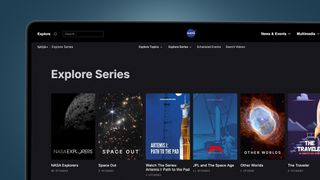NASA’s answer to Netflix has just landed – here’s how to watch NASA Plus
It’s a good week for those of us who used to take space shuttles to school: it’s not just that For all humanity is coming back to Apple TV, but the new NASA Plus streaming service just launched.
Unlike the fictional Apple TV Plus show, there won’t be any gunfights on the moon, but there’s plenty to please fans of space exploration. NASA Plus is an ad-free and fee-free streaming service (the best kind) that offers original video series, live coverage, and some new series as well.
You can tune into NASA Plus in the NASA app on iOS and Android phones, and also find it on streaming platforms like Roku, Apple TV, Amazon Fire TV, and more. Need a quick tour of the new TV space station? Here’s everything you need to know.
What is NASA Plus?
NASA Plus is the space agency’s first on-demand streaming service and is located in the recently updated NASA app.
NASA says the service is available on “most major platforms,” including Android, iOS, Apple TV, Fire TV, Roku, and on the web. It also promises that all content will be family-friendly and include Emmy-winning live shows, in addition to “a handful of new series” (more on that below).
In short, NASA Plus’ focus is on news and educational content, rather than reruns Interstellar or The Martian. That means some exclusive interviews, feature stories and more, in addition to a few exclusive series, which NASA claims will provide “space on demand and at your fingertips.” You can’t say that about Freevee.
How can you watch NASA Plus?
You can now watch NASA Plus for free via the newly updated NASA app on most mobile and TV platforms.
To watch on your smartphone, simply download the NASA app for iOS or the NASA app for Android. If you prefer to watch on the big screen, you can also download the NASA app for Roku, Apple TV or Amazon Fire TV – or simply tune in via your web browser on desktop or mobile devices.
In a refreshing change from recent streaming price increases, NASA Plus will be free. And it won’t be full of ads either; NASA says it will be ad-free. NASA gets money from Congress so it doesn’t have to run ads to cover costs; the broadcasts are considered a public service.
What can you watch on NASA Plus?
As NASA promised, the streaming service will offer a range of content, including updates on current missions, behind-the-scenes videos, and live streams of interesting events. But perhaps the most interesting are the documentaries and docuseries.
Currently, there are 25 series available to stream on NASA Plus, although this library will grow over time. These range from family friendly such as Elmo visits NASA to multi-part documentaries and originals.
You can get a taste of some of these originals in the trailers of The traveller, NASA explorers, And Other worlds (below). The Traveler is a kid-friendly series dramatically billed as “the space agency’s greatest adventure yet” but hosted by a friendly Martian.
With a similar theme there are also shows included Lucy, an animated series about a cheerful space probe that goes on epic adventures. Lucy was previously available on the NASA YouTube channel.
On a slightly more serious note: NASA explorers is a documentary about the OSIRIS-REx spacecraft, the first American mission to collect a sample of an asteroid. He returned to Earth on September 24 to deliver his material, which will help us learn more about the origins of the solar system and what exactly asteroids brought to Earth billions of years ago.
If astronomy is more your thing, you might also want to tune in Other worlds, in which scientists respond to new information picked up by the James Webb Space Telescope, the world’s most powerful observatory. You can watch the first episode now on NASA Plus.
Is NASA Plus the same as NASA TV?
No, that’s not it. NASA TV is a traditional TV channel, but NASA Plus is the agency’s first on-demand streaming service. Content from the former will undoubtedly be shown on the latter, but the big advantage is that you can get NASA Plus on virtually any device, whenever you want.
The launch of the new service is part of a broader program: NASA is “elevating its digital platforms for the benefit of all” by revamping its flagship websites. “With these changes, everyone will have access to a new world of space agency content.” And that’s definitely a good thing, especially for space fans.

